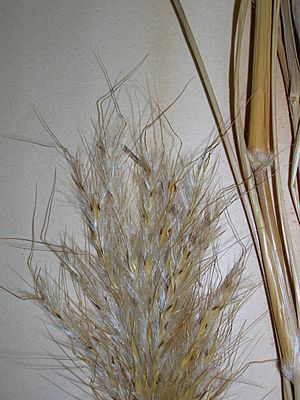Cane bluestem facts for kids
Quick facts for kids Cane bluestem |
|
|---|---|
 |
|
| Scientific classification | |
| Genus: |
Bothriochloa
|
| Species: |
barbinodis
|
| Synonyms | |
|
Andropogon barbinodis |
|
Bothriochloa barbinodis is a type of grass commonly known as cane bluestem. This grass grows naturally across a large part of the Americas. You can find it in most of South and Central America, Mexico, and the very southern parts of the United States, from California all the way to Florida.
Contents
What is Cane Bluestem?
Cane bluestem is a perennial bunchgrass. This means it lives for more than two years and grows in clumps, like a small bush. It can grow quite tall, usually between 60 and 120 centimeters (about 2 to 4 feet).
What Does it Look Like?
The stems of cane bluestem are straw-colored. They have special joints called nodes. These nodes are covered with soft, fluffy hairs, which makes them look interesting.
The leaves are long, about 20 to 30 centimeters (8 to 12 inches). When they first grow, they are a pretty blue-green color. As they get older, they change to a reddish-yellow.
The plant's flowers grow in a feathery shape called an inflorescence. Each part of this feathery cluster is made of two small units called spikelets. One spikelet is fertile, meaning it can make seeds. It is hairy and tan, with a twisted "awn" (a long, thin bristle) up to 3.5 centimeters long. The other spikelet is sterile and much smaller, without an awn. The seeds from these hairy spikelets are carried by the wind to new places.
Why is Cane Bluestem Important?
In the places where it grows naturally, cane bluestem is very useful.
- Food for Animals: It provides forage for grazing animals, like cattle. This means animals can eat it to get their energy.
- Helping Land Recover: It's also good for covering land that has been cleared. It helps new plants grow back and protects the soil.
- Tough Plant: This grass is very good at handling dry weather. It is known for being very drought resistant, meaning it can live even when there isn't much rain.
What Does it Tell Us About Land?
Cane bluestem can also act like a warning sign for rangeland. Rangelands are large areas where animals graze. If too many animals eat the grass in one area (this is called overgrazing), cane bluestem is often one of the first native plants to disappear. So, if you see less of this grass, it might mean the land is being used too much.
Where Else Does it Grow?
Sometimes, cane bluestem is found in places where it doesn't naturally belong. When a plant grows somewhere new because people brought it there, it's called an introduced species. In some places, like Hawaii, it can even become a noxious weed. This means it grows too much and can cause problems for other plants.
Grown for Beauty
People also grow cane bluestem as an ornamental plant. This means they grow it because its feathery flower clusters look pretty in gardens or landscapes.

